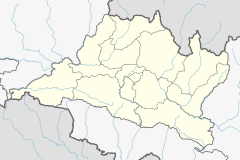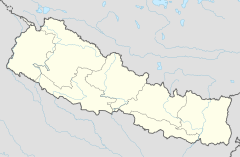| Boudha Stupa or Jarung Kashor | |
|---|---|
बौद्धनाथ खास्ति माहाचैत्य | |
 The Stupa of Boudanath, a UNESCO World Heritage Site | |
| Religion | |
| Affiliation | Buddhism, Hinduism |
| Location | |
| Location | Kathmandu, Nepal |
| Geographic coordinates | 27°43′17″N 85°21′43″E / 27.72139°N 85.36194°E |
| Architecture | |
| Type | Stupa |
| Height (max) | 36 metres (118 ft)[1] |
| Official name: Bauddhanath, part of Kathmandu Valley | |
| Type | Cultural |
| Criteria | iii, iv, vi |
| Designated | 1979 (3rd session), revised 2006 |
| Reference no. | 121bis-005 |
| State Party | |
Boudha Stupa (Nepali: बौद्धनाथ; Newari: खास्ति चैत्य); or Jarung Kashor (Let it be done, Slip of the tongue)[2](Standard Tibetan: བྱ་རུང་ཀ་ཤོར།, Wylie: bya rung ka shor), also known as Khasti Chaitya or Khāsa Chaitya, is a stupa and major spiritual landmark[3] seen as the embodiment of the enlightened mind of all the Buddhas,[2][3][4] located in Boudhanath, within the city of Kathmandu, Nepal.[5] Built in the northeast of Kathmandu Valley in a Tamang village surrounded by rice paddies,[3] the stupa gave birth to the origins of Tibetan Buddhism.[2] It is filled with consecrated substances,[4] and its massive mandala makes it the largest spherical stupa in Nepal[6] and one of the largest in the world. In 1979 the Boudha Stupa became one of UNESCO's World Heritage Sites in Nepal.

The stupa's consecrated Body relics include authentic bone pieces of Kassapa Buddha[2] and of Shakyamuni Buddha,[4] together with Dharmakaya relics, Dharma relics, Cloth relics, and Body, Speech, Mind, Mind Qualities, and Activity representations among its other relics.[4] It is located on the ancient trade route from Tibet to India which enters the Kathmandu Valley by the village of Sankhu in the northeast corner and continues to the ancient and smaller stupa of Chabahil named Charumati Stupa, often called "Little Boudhanath". The route then turns directly south, heading over the Bagmati River to Lalitpur and the ancient Malla Kingdom in Patan.[5] Tibetan merchants have rested and offered prayers at Boudha Stupa for many centuries.

Following the 1959 Tibetan uprising, a large number of the Tibetan refugees migrated to Nepal and settled down around the stupa in Boudhanath.[7] The Tibetan diaspora has given rise to the construction of over 50 gompas and Budhhist monasteries, restaurants, guesthouses, and artisanal businesses around Boudhanath, while in 1980, Shechen Monastery was the first Tibetan Buddhist gompa to be built. A year earlier in 1979, the Boudha Stupa became a UNESCO World Heritage Site. Along with Swayambhunath and Namo Buddha, it is one of the most visited pilgrimage sites for devout Buddhists, which also attracts tourists to the Kathmandu area.
Built at the main northern entrance to the Boudha Stupa is a shrine to the Dharma protectress Mammo Pukkasi, known as the fierce Hariti or Ajima to local Newari Buddhists.[3] Her shrine and the Ganachakra offerings there are the responsibility of the Mahaguru Gompa, which faces the stupa's northern entrance.

- ^ Department of Archaeology (Nepal). "Bouddha Stupa". Retrieved 3 May 2014.
- ^ a b c d Padmasambhava, "The History of the Great Jarung Kashor Stūpa", Recorded by Yeshe Tsogyal and hidden as terma; Discovered by Lhatsün Ngönmo, rediscovered by Ngakchang Shakya Zangpo; Translated by Samye Translations. Lotsawa House, https://www.lotsawahouse.org/tibetan-masters/ngakchang-shakya-zangpo/great-history-of-jarung-kashor-stupa
- ^ a b c d Samye Translations, "Boudha: The Great Jarung Kashor Stupa", Nekhor: Circling the Sacred, Itineraries for Buddhist pilgrims in Nepal.
- ^ a b c d Tulku Rigdzin Pema Tenzin Dorje, "Inventory of Jarung Khashor Stūpa", 27 October 2017. Translated by Drubchen Dorje, Edited by Stephan Mang, Lotsawa House.
- ^ a b Snellgrove, David. Indo-Tibetan Buddhism: Indian Buddhists and Their Tibetan Successors, 2 vols., p. 365. (1987) Shambhala Publications, Boston. ISBN 0-87773-311-2 (v. 1); ISBN 0-87773-379-1 (v. 2).
- ^ "Fables of Boudha Stupa and Changunarayan". The Independent, Nepal News. X (26). 16–22 August 2000. Archived from the original on 2007-02-09.
- ^ Prasad, Madhav (2023-06-09). "Major attractions in Nepal". Mosaic Adventure. Retrieved 2023-06-25.


